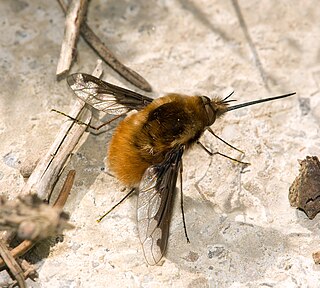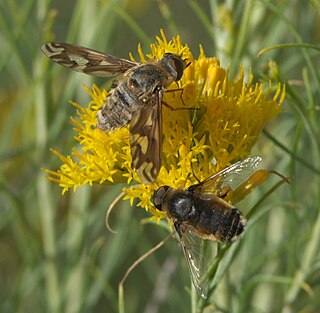
The Bombyliidae are a family of flies, commonly known as bee flies. Some are colloquially known as bomber flies. Adults generally feed on nectar and pollen, some being important pollinators. Larvae are mostly parasitoids of other insects.

Poecilanthrax willistonii, Williston's bee fly or sand dune bee fly, is a member of the Bombyliidae insect family. This family includes the bee flies, true flies that have developed Batesian mimicry characteristics to avoid predators. That is, they look like bees because that helps them avoid bee-wary predators, but they lack stingers.

Anthracinae is a subfamily of bee flies in the family Bombyliidae. There are more than 80 genera and 2,000 described species in Anthracinae.
Exoprosopa parda is a species of bee fly in the family Bombyliidae.

Villini is a tribe of bee flies in the family Bombyliidae.

Pantarbes capito is a species of bee fly in the family Bombyliidae. It is found in the southwestern United States from California to Wyoming.
Lepidanthrax rauchi is a species of bee fly in the family Bombyliidae. It is found in Mexico and Arizona.

Lepidanthrax is a genus of bee flies in the family Bombyliidae. There are at least 50 described species in Lepidanthrax. The genus is primarily North and Central American, but one species is recorded from the Galapagos Islands and two are recorded from Australia.
Paravilla separata is a species of bee flies in the family Bombyliidae.
Lepidophora vetusta is a species of bee fly in the family Bombyliidae. It is found in Texas, Mexico, and Central America as far south as Costa Rica.
Stonyx is a genus of bee flies in the family Bombyliidae. There are five described species in the genus Stonyx.
Amphicosmus arizonensis is a species of bee fly in the family Bombyliidae. It is known from Arizona.
Neodiplocampta mirella is a species of bee fly in the family Bombyliidae. It is known from California.
Lepidanthrax disjunctus is a species of bee fly in the family Bombyliidae. It is known from Mexico and Arizona.
Lepidanthrax eremicus is a species of bee fly in the family Bombyliidae. It is known from California.

Geron is a genus of bee flies in the family Bombyliidae. There are at least 180 described species in the genus Geron, found on every continent except Antarctica.
Systropus macer is a species of bee fly in the family Bombyliidae. It is found in eastern North America in Ontario, Canada, and in the United States from Massachusetts south to Georgia and Texas. It is a parasitoid of Limacodidae caterpillars, including Adoneta spinuloides, Euclea delphinii, Lithacodes fasciola, Prolimacodes badia, and Parasa indetermina.
Xenox habrosus is a species of bee fly in the family Bombyliidae. It is found in Mexico, California, and Arizona.
Paravilla aridula is a species of bee fly in the family Bombyliidae. It is found in Arizona and California.
Hemipenthes inops is a species of bee fly in the family Bombyliidae. It is found in the western United States. It is somewhat unusual compared to other members of the genus Hemipenthes in that its wings are mostly transparent.






